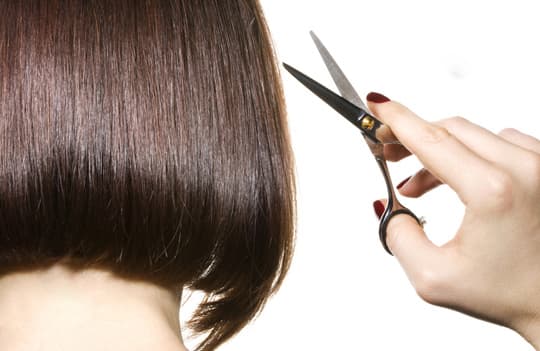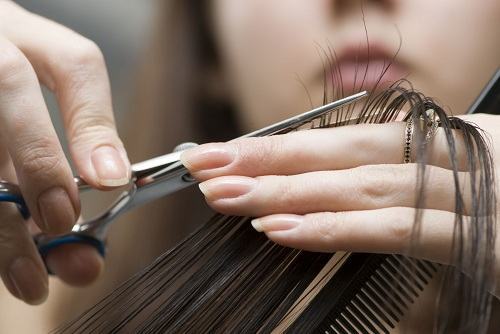SO YOUR HAIR is getting long. Most salons reopened when vaccines became available, but with a new variant spreading around, you may feel more cautious. You may also have a difficult time finding an appointment.
Stylists will advise you to avoid getting too zealous with your scissors, but sometimes you’re left with no choice but to take matters into your own hands. Cutting your hair is more complicated than it looks, and this guide is not one-size-fits-all, but it should at least help you figure out the basics on where to start.

Do You Really Need a Cut?
There are plenty of ways to change your look without being extreme or doing something you may regret. As my hairstylist Angela Layng says, “We never make our best hair decisions when we’re stressed.” Additionally, the stylists I’ve interviewed emphasized the fact that home haircuts can quickly go awry. Just take a look at the videos of people trying to give themselves bangs.
Before you make any permanent changes to your hair, consider some temporary ones. It’s still a great time to grow out your hair. You can also fake a hair transformation. Create a faux bob with the help of some bobby pins, or don a cool hat. If your hair is long enough to put into a ponytail, you can use creative styling to create fake bangs with no scissors required. Try covering your head in barrettes or learn to fishtail braid. Experiment away!
Gear You May Need to Cut
Quality scissors: A sharp edge helps prevent your hair from fluffing out at the ends or moving around too much while you trim. Consider using precision scissors or placing an order for hair-cutting shears, which are razor-sharp and should be handled with care.
Hair clippers for short hair: Hair clippers have been tricky to find ever since early 2020, but this is a good clipper kit if you can manage to snag it—and this is a good alternative. This beginner-friendly trimmer might be of assistance if you plan to fly solo.
Keep These Tips in Mind
Get help: Cutting your own hair in the mirror can be tricky. If you can, get someone to help you trim evenly or decide when enough is enough. If you have to go it alone, use multiple mirrors and take breaks to check up on how you’re looking.
Consider texture and length: Mistakes may be easier to spot if your hair happens to be curly, short, dry, or especially textured, so use caution.
Start small: Have you ever used a magnifying mirror to tweeze your eyebrows, only to step back and realize you’ve gone too far? The same principle applies to your hair. You can always take off more, but there’s no going back once you’ve snipped away too much. It may help to step away for a few hours before you reassess where you’re at.
Avoid horizontal lines: It might have looked badass when Disney’s Mulan did it, but you don’t want to hack your hair off in a big horizontal line. Hold your scissors straight up and down the length of your hair, rather than across it, and snip away just a little bit at a time. This is especially important if you’re working on bangs. Horizontal lines are sometimes necessary for removing length, but snipping vertically keeps your hair from becoming too blunt—a telltale sign of at-home haircuts. If you’ve cut horizontally, make sure to follow it up with vertical snips to thin out the ends and make the cut look more natural. If you aren’t feeling dextrous enough to cut vertically, try holding your scissors diagonally.

How to Trim Your Hair
Be conservative. Focus on trimming your hair—don’t try to completely restyle it. When in doubt, you can always wait and book an appointment with your favorite stylist once you’re fully vaccinated and they have time to see you. Below is our best trimming advice, along with some links to tutorials that will help you with the basics.
Wash and condition your hair, and then let it dry completely, because hair shrinks as it dries. This will help you avoid taking off too much. Work out any tangles using a brush before getting started. If your hair is unruly, you can mist it with water, but try to avoid getting it too saturated.
Make sure you have your shears or clippers and a comb on hand. Use clips to help section your hair into manageable segments. Snip with the ends of the shears rather than with the full length of the blade.
Drape a cape (or an old towel) over your shoulders.
Follow the advice below that best applies to your hair.
For Long Hair
Divide your hair and clip it into sections. Bring one section forward at a time, and determine how much you want to take off—we suggest a quarter of an inch to half an inch. (Cut a little less than you think you should.) Trim off the length and then snip the ends to add texture and blend everything out. Watch this video for more in-depth instructions.
For Short Hair
Short hair is an instance where having damp locks may help you out. We suggest having someone else do the job for you. Less is more. If you’re using shears, have your assistant start at the sides and work around your head. They can use a comb to help guide the shears and determine where to cut. Be extra careful when trimming around the ears. This video is a good tutorial for a classic short cut using shears.
If you’re using clippers, this is a helpful basic tutorial. And to cut your own short hair, try this video tutorial, and consider using a special self-haircut kit to make the process a little easier.
For Curly Hair
The type of trim you’ll want depends on your curl type (check your curl type here). For looser 2A to 3B curls, you can probably follow this tutorial, where you work with dry hair and trim curl by curl at an angle to ensure voluminous results.
For tighter curl types ranging from 3C to 4C, try sectioning your hair, gently detangling, and using firm pressure to keep it from moving too much as you trim. This tutorial and this tutorial are both great options for highly textured hair.
Depending on your curl pattern and your hair shape, you may want to find a video more tailored to your desired end result. YouTube is your friend. Remember that curly hair has a mind of its own, so be patient and work in small sections.
For Kids’ Hair
If you can get kids to stay still, a haircut isn’t too hard. This is a good guide for blending short haircuts and dealing with cowlicks, and here’s a tutorial for classic shaggy toddler haircuts. When in doubt, you can always use a mixing bowl (or a headband). Just don’t use this method when they’re older. By high school, a bowl cut is not going to help their social standing. The nineties might be back in style, but not to that extent.
For Bangs
If you already have them, and they’re getting too long, this is a great tutorial for trimming bangs.
If you don’t already have bangs, stylists don’t advise doing them yourself. Leave bangs to the professionals. They are extremely tricky to get right, and a botched fringe takes forever to grow out. Instead, consider purchasing some clip-ins. I like Insert Name Hair’s Zooey bangs, and you can also find clip-in bangs on Amazon (or fake them with a clever ponytail, if your hair is long enough.)
